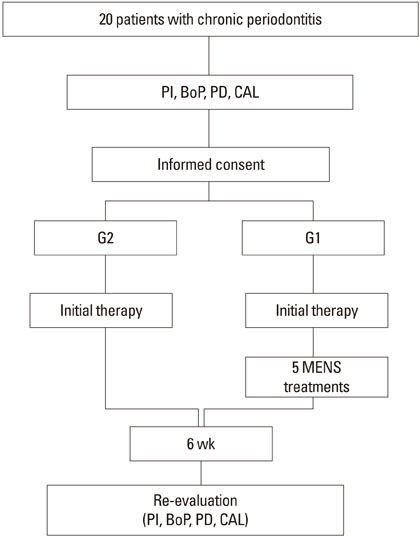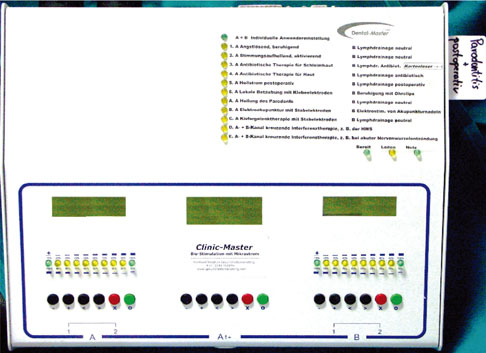J Periodontal Implant Sci.
2011 Jun;41(3):117-122. 10.5051/jpis.2011.41.3.117.
Efficacy of electrical neuromuscular stimulation in the treatment of chronic periodontitis
- Affiliations
-
- 1Department of Periodontology, University of Zagreb School of Dental Medicine, Zagreb, Croatia. puhar@sfzg.hr
- 2Health Centre County of Zagreb, Zagreb, Croatia.
- 3Department of Operative Dentistry and Periodontology, University Medical Center Mainz, Johannes Gutenberg-University, Mainz, Germany.
- 4Private Practice and Department of Oral Medicine and Periodontology, University of Rijeka, Rijeka, Croatia.
- KMID: 1783601
- DOI: http://doi.org/10.5051/jpis.2011.41.3.117
Abstract
- PURPOSE
The purpose of the present randomized controlled clinical study was to evaluate the short-term outcomes of microcurrent electrical neuromuscular stimulation (MENS) as an adjunct method to nonsurgical periodontal therapy.
METHODS
Twenty patients with moderate to severe chronic periodontitis were recruited into the study and randomly treated with either nonsurgical periodontal therapy followed by 5 MENS treatments with a microcurrent device or by nonsurgical periodontal therapy alone. Periodontal parameters were measured at baseline and 6 weeks following therapy, and included the plaque index, bleeding on probing, probing depth, and clinical attachment level (CAL).
RESULTS
All measured values were reduced at the time of re-evaluation. The amount of inflammation was significantly reduced in both the test (P=0.002) and control group (P=0.015). The test group demonstrated a significant CAL gain at 6 weeks following therapy, including non-molar (P=0.009) and molar teeth (P=0.028). In comparison with the control group, the test group showed statistically significant differences in the CAL on both molar (P=0.027) and non-molar teeth (P=0.031).
CONCLUSIONS
In conclusion, the short-term results of the study indicate that MENS could be a suitable adjunctive method in the treatment of chronic periodontitis.
MeSH Terms
Figure
Reference
-
1. Claffey N, Polyzois I. Lindhe J, Lang NP, Karring T, editors. Non-surgical therapy. Clinical periodontology and implant dentistry. 2009. Oxford: Blackwell Munksgaard;767–779.2. Groeneveld MC, Everts V, Beertsen W. A quantitative enzyme histochemical analysis of the distribution of alkaline phosphatase activity in the periodontal ligament of the rat incisor. J Dent Res. 1993. 72:1344–1350.
Article3. Yoshimura N. Effects of electrical stimulation on periodontal tissue regeneration in dogs. J Kyushu Dent Soc. 1993. 47:590–606.
Article4. Cheng N, Van Hoof H, Bockx E, Hoogmartens MJ, Mulier JC, De Dijcker FJ, et al. The effects of electric currents on ATP generation, protein synthesis, and membrane transport of rat skin. Clin Orthop Relat Res. 1982. (171):264–272.5. Bassett CA. Fundamental and practical aspects of therapeutic uses of pulsed electromagnetic fields (PEMFs). Crit Rev Biomed Eng. 1989. 17:451–529.6. Bach S, Bilgrav K, Gottrup F, Jørgensen TE. The effect of electrical current on healing skin incision. An experimental study. Eur J Surg. 1991. 157:171–174.7. Nessler JP, Mass DP. Direct-current electrical stimulation of tendon healing in vitro. Clin Orthop Relat Res. 1987. (217):303–312.
Article8. Carley PJ, Wainapel SF. Electrotherapy for acceleration of wound healing: low intensity direct current. Arch Phys Med Rehabil. 1985. 66:443–446.9. Ciombor DM, Aaron RK. The role of electrical stimulation in bone repair. Foot Ankle Clin. 2005. 10:579–593. vii
Article10. Brighton CT, Friedenberg ZB, Mitchell EI, Booth RE. Treatment of nonunion with constant direct current. Clin Orthop Relat Res. 1977. (124):106–123.
Article11. Jacobs JD, Norton LA. Electrical stimulation of osteogenesis in pathological osseous defects. J Periodontol. 1976. 47:311–319.
Article12. Kaynak D, Meffert R, Günhan M, Günhan O. A histopathologic investigation on the effects of electrical stimulation on periodontal tissue regeneration in experimental bony defects in dogs. J Periodontol. 2005. 76:2194–2204.
Article13. Bruzek DB, Geistfeld NS. Clinical study to evaluate the use of electronic anesthesia during dental hygiene procedures. Northwest Dent. 1996. 75:21–26.14. Reuter E, Krekeler G, Krainick JU, Thoden U, Doerr M. Pain suppression in the trigeminal region by means of transcutaneous nerve stimulation. Dtsch Zahnarztl Z. 1976. 31:274–276.15. teDuits E, Goepferd S, Donly K, Pinkham J, Jakobsen J. The effectiveness of electronic dental anesthesia in children. Pediatr Dent. 1993. 15:191–196.16. Oztaş N, Olmez A, Yel B. Clinical evaluation of transcutaneous electronic nerve stimulation for pain control during tooth preparation. Quintessence Int. 1997. 28:603–608.17. Hargitai IA, Sherman RG, Strother JM. The effects of electrostimulation on parotid saliva flow: a pilot study. Oral Surg Oral Med Oral Pathol Oral Radiol Endod. 2005. 99:316–320.
Article18. Strietzel FP, Martín-Granizo R, Fedele S, Lo Russo L, Mignogna M, Reichart PA, et al. Electrostimulating device in the management of xerostomia. Oral Dis. 2007. 13:206–213.
Article19. Page RC, Eke PI. Case definitions for use in population-based surveillance of periodontitis. J Periodontol. 2007. 78:7 Suppl. 1387–1399.
Article20. Todd I, Clothier RH, Huggins ML, Patel N, Searle KC, Jeyarajah S, et al. Electrical stimulation of transforming growth factor-beta 1 secretion by human dermal fibroblasts and the U937 human monocytic cell line. Altern Lab Anim. 2001. 29:693–701.
Article21. Plemons J, Eden BD. Rose LF, Mealey BL, Genco RJ, editors. Nonsurgical therapy. Periodontics: medicine, surgery, and implants. 2004. St. Louis: Elsevier Mosby;237–262.22. Claffey N, Egelberg J. Clinical indicators of probing attachment loss following initial periodontal treatment in advanced periodontitis patients. J Clin Periodontol. 1995. 22:690–696.
Article23. Claffey N, Polyzois I, Ziaka P. An overview of nonsurgical and surgical therapy. Periodontol 2000. 2004. 36:35–44.
Article
- Full Text Links
- Actions
-
Cited
- CITED
-
- Close
- Share
- Similar articles
-
- Neuromuscular Electrical Stimulation for Dysphagia
- Neuromuscular Electrical Stimulation for Swallowing
- The Effect of Electrical Stimulation on Spasticity in Hemiplegic Patients
- Evidence Based Review of Neuromuscular Electrical Stimulation for Swallowing
- Effect of EMG-triggered Electrical Stimulation to Improve Arm Function in Patients with Chronic Hemiplegia




